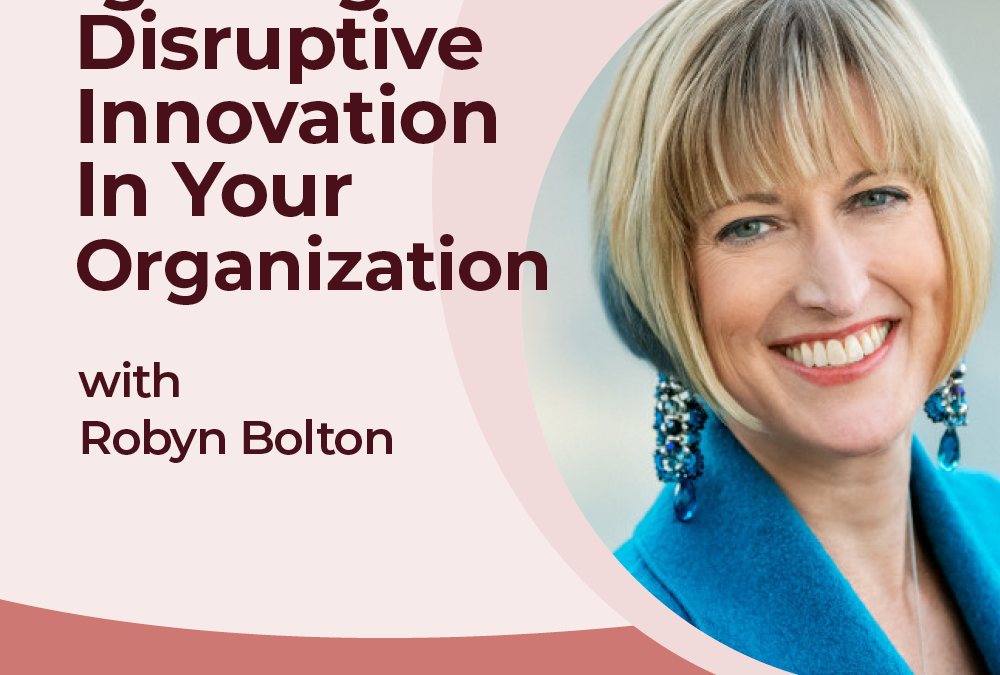
by Robyn Bolton | Aug 18, 2022 | Customer Centricity, Innovation, Tips, Tricks, & Tools
Most of my advice to leaders who want to use innovation to grow their businesses boils down to two things*:
- Talk (and listen) to customers
- Do something
But what if you don’t want to talk to customers?
After all, talking to customers can be scary because you don’t know what they’ll say. It can be triggering if they say something mean about your product, your business, or even you as a person. It can be draining, especially if you’re an introvert.
Plus, there are so many ways to avoid talking to customers – Send a survey, hire a research firm to write a report, invoke the famous Steve Jobs quote about never doing customer research.
Isn’t it just better to stay tucked away in the office, read reports, state opinions as if they are facts (those opinions are based on experience, after all), and make decisions?
Nope.
It is not better. It is also not safer, easier, or more efficient.
To make the best decisions, you need the best data, which comes from your customers.
But that doesn’t mean you need to talk to them to get it.
The best data
The best data helps you understand why your customers do what they do. This is why Jobs to be Done is such a powerful tool – it uncovers the emotional and social Jobs to be Done that drive our behavior and choices (functional Jobs to be Done are usually used to justify our choices).
But discovering Jobs to be Done typically requires you to talk to people, build rapport and trust in a one-on-one conversation, and ask Why? dozens of times so surface emotional and social JTBD.
Luckily, there are other ways to find Jobs to be Done that don’t require you to become an unlicensed therapist.
Observe your customers
Go where your customers are (or could be) experiencing the problem you hope to solve and try to blend in. Watch what people are doing and what they’re not doing. Notice whether people are alone or with others (and who those others are – kids, partners, colleagues, etc.). Listen to the environment (is it loud or quiet? If there’s noise, what kind of noise?) and to what people are saying to each other.
Be curious. Write down everything you’re observing. Wonder why and write down your hypotheses. Share your observations with your colleagues. Ask them to go out, observe, wonder, and share. Together you may discover answers or work up the courage to have a conversation.
Quick note – Don’t be creepy about this. Don’t lurk behind clothing racks, follow people through stores, peep through windows, linger too long, or wear sunglasses, a trench coat, and a fedora on a 90-degree day, so you look inconspicuous. If people start giving you weird looks, find a new place to people-watch.
Observe yourself
Humans are fascinating, and because you are a human, you are fascinating. So, observe yourself when you’re experiencing the problem you’re hoping to solve. Notice where you are, who is with you, the environment, and how you feel. Watch what you do and don’t do. Wonder why you chose one solution over another (or none).
Be curious. Write down everything you did, saw, and felt and why. Ask your colleagues to do the same. Share your observations with your colleagues and find points of commonality and divergence, then get curious all over again.
Quick note – This only works if you have approximately the same demographic and psychographic profiles and important and unsatisfied Jobs to be Done of your target customers.
Be your customer
What if your business solves a problem that can’t be easily observed? What if you don’t have the problem that your business is trying to solve?
Become your customer (and observe yourself).
Several years ago, I worked with a client that made adult incontinence products. I couldn’t observe people using their products, and I do not have important (or unsatisfied) Jobs to be Done that the products can solve.
So, for one day, I became a customer. I went to Target and purchased their product. I went home, wore, and used the product. I developed a deep empathy for the customer and wrote down roughly 1 million ways to innovate the product and experience.
Quick note – Depending on what’s required to “be your customer,” you may need to give people a heads up. My husband was incredibly patient and understanding but also a little concerned on the day of the experiment.
It’s about what you learn, not how you learn it
It’s easy to fall into the trap of thinking there is one best way to get insights. I’m 100% guilty (one-on-one conversations are a hill I have died on multiple times).
Ultimately, when it comes to innovation and decision-making, the more important thing is having, believing, and using insights into why customers do what they do and want what they want. How you get those insights is an important but secondary consideration.
* Each of those two things contains A TON of essential stuff that must be done the right way at the right time otherwise, they won’t work, but we’ll get into those things in another article

by Robyn Bolton | Aug 10, 2022 | Customer Centricity, Innovation, Tips, Tricks, & Tools
Between theory and practice is a nearly infinite chasm of superficial understanding and unearned confidence. This is no more true than in the case of Jobs to be Done (JTBD), and I can say that with confidence because I spent years in the chasm.
Years.
But I clawed my way up and out and experienced why JTBD is the single most powerful and transformative tool you can use to drive growth.
Want to skip the dive into the canyon and the long slow climb out?
What is Jobs to be Done (JTBD)?
A Job to be Done is a problem that a person is experiencing and/or progress a person wants to make in a given circumstance.
Although the origins of the phrase and theory are up for debate, many people point to Clayton Christensen, author of The Innovator’s Dilemma, as the originator of the phrase. (if you enjoy a good nerd-fight, and who doesn’t, you can read more from each person claiming to be The creator here, here, here, and here)
“The Milkshake Story” is an excellent example of JTBD. You can watch Clay tell it here. Or, remember the first, and still beautifully correct, articulation of JTBD, from a 1923 ad for a plumbing company in Reno, Nevada:
“When you buy a razor, you buy a smooth chin—but you could wear a beard.
When you buy a new suit, you buy an improved appearance—but you could make the old one do.
When you buy an automobile, you buy speedy transportation—but you could walk.
But when you buy plumbing, you buy cleanliness—for which there is no substitute!”
Why is JTBD so amazing?
Jobs to be Done surfaces the Why behind the What.
When you ask, “What do you want?” you’re asking people to define the solution. Whatever they say will be wrong because it is rooted in what exists. That’s why everyone from Henry Ford (supposedly) to Steve Jobs dismissed the usefulness of customer research.
If you ask the wrong question (What do you want?), you’ll get the wrong answer.
When you ask, “Why?” you’re asking people to define the problem. Whatever they say will be right (true) because it is rooted in their experience – the pain, frustration, and annoyance of today’s inadequate solutions.
Once you pair your understanding of why something works or doesn’t work with your knowledge of what is possible (not just what currently exists), then YOU are defining a solution that does its job better than anything else on the market.
When should you use Jobs to be Done?
Always. There is no “wrong” time to use it, and it’s valuable at every step of the innovation process:
- Discovery: Identify un- or under-served markets by finding important and unsatisfied JTBD
- Ideation, solution development, prototyping, market testing: Assess how well ideas solve important and unsatisfied JTBD and whether people are willing to pay for satisfaction
- Post-launch: Understand how JTBD are shifting in importance and satisfaction as new solutions enter the market and change the basis of competition
How to identify Jobs to be Done
Full disclosure, everything that follows sounds simple but is extremely challenging. I’ve trained hundreds of people in this process. 1% immediately do it well. At least 50% never figure it out. The other 49% of us practice every chance we get – from formal qualitative research to casual conversations with friends – and eventually, we get it.
Always start with one-on-one conversations because you don’t know what you don’t know (even if you think you know, trust me, you don’t). You’re going to ask questions that invite people to bare their souls and all of their quirks, and they will. But not if there’s a crowd.
- Identify no more than three questions that must be answered by the end of the conversation. Any more than that, you run the risk of the conversation becoming an interrogation, and no one will reveal their quirks and insecurities if they feel interrogated.
- Be human. Introduce yourself as a person (where you live, why you’re interested in speaking with them, what interests you about the topic), not as a professional (name, title, serial number). Humans want to connect with humans, not business cards.
- Be genuinely interested in the person you’re talking to. Ask them to introduce themselves and chime in when you find a shared interest. People will share more with you if you share with them.
- Ask only open-ended questions. People want to share their story. Let them. Don’t rush them. If they start to go off track, gently guide them back. This is about them, not you.
- Ask at least two follow-up questions. The first answer is never the real answer. It’s the answer they think you want to hear or the answer that puts them in the best light. Ask, “Why?” Say, “Tell me more.” Encourage with “And what else?” You’ll get the real answer only if you are patient and curious.
- Let the silence work for you. Ask the question and then stop talking. Don’t offer potential answers. Don’t explain the question. Just ask and shut up. In more Western cultures, silence is deeply uncomfortable, so people will do almost anything to fill it, including sharing their quirks and baring their souls. Sit and silently count to 8. Most people will start talking by five.
Once you identify Jobs to be Done, usually through approximately 10 JTBD conversations, you know what you don’t know. From here, you can use focus groups to refine your insights, surveys to quantify the market, or ideation sessions to develop solutions.
In conclusion
If you want to cross (or avoid) the chasm between reading about Jobs to be Done and using it as a tool to create value and growth, you’ve got to go beyond theory and DO the work.
As with all new skills, you’ll need to be bad at it before you can be good at it. But with practice, you WILL get good.
You may even use your deep understanding and well-earned confidence to help others make the crossing.

by Robyn Bolton | Aug 2, 2022 | Innovation
You know that innovation is essential and why it is essential.
But do your colleagues share your views?
They probably don’t, which creates a huge stumbling block in your innovation efforts.
Just like it’s essential to agree on what “innovation” is, it’s also crucial to agree on why it’s important, what it must deliver, and by when.
This step may seem silly, after all, everyone knows that innovation is essential. But skipping it will lead to misunderstanding, missed expectations, and, ultimately, the end of your innovation efforts as senior executives grow increasingly confused and frustrated by your activities and results (or lack thereof).
Don’t believe me?
Why companies innovate
Following (in no particular order) are the most common reasons senior executives give me for investing in innovation:
- We need revenue growth
- Shareholders expect us to say something about it
- We risk losing our reputation as an innovative company
- It’s hard to recruit and/or retain talent if we’re not seen as innovative
- We need the PR
- Our CEO attended an event/read a book/saw an article/had a conversation
What do you notice about the list?
Only one of the reasons, “we need revenue growth,” is tied to a business strategy and metric,
The other reasons focus either on managing perceptions or keeping people happy.
Of course, companies can invest in innovation for several reasons, but there is always one that is more important than the others. One reason will ultimately become the metric against which innovation efforts are judged, and success or failure is decided.
Why you need to know Why
Imagine that you see a $100M growth gap (difference between what current offerings can deliver and future expectations) and view innovation as essential to closing that gap. You present this insight to senior leaders and, now sharing your concern, they agree to invest $1M and two full-time employees (both internal transfers) for the next fiscal year.
You and your team hit the ground running. Together, you set up a basic innovation process, send the team out to talk to customers and study the market with an eye to untapped opportunities, and build relationships across other functions to ensure you have support when you need it.
By the end of Year 1, your team identified several multi-million-dollar opportunities, prototyped and tested dozens of concepts, and built business cases for five new brands capable of closing the revenue gap.
The progress is impressive, especially considering it happened within a context of higher-than-expected employee turnover, increasing competition from old and new companies, and an unreliable and unpredictable supply chain.
This is why you are crushed when senior leaders thank you for your efforts, say they’ll consider your recommendations, then cut your budget and re-assign your team.
As you and your team doggedly worked to close a revenue gap, senior leaders’ priorities changed to defending the current business and reputation, and they need news and new products now, not in three years.
Can innovation help with all that? Of course! But senior leaders didn’t realize that, and while you were busy working, they began implementing solutions to their most pressing pain points.
How to find the Why
Ask early.
At the start, have a conversation with key decision makers and stakeholders, especially the people who are allocating resources to your innovation endeavor.
Ask 3 questions:
- How do you define innovation?
- Why is innovation important to our business?
- What does innovation need to deliver, and by when?
You will likely get long, rambling answers to each question because (1) the answers seem self-evident, so the person you’re talking to never stopped to collect and clarify their thoughts before you asked these questions, and (2) long answers keep options open.
Ask follow-up questions that narrow down the options (you can’t be and do everything, and you certainly don’t have the resources to try!)
- If you had to pick 2-3 as the most important, what would you pick?
- If you had 100 chips to allocate across (give the list of items), how would you distribute them?
- If I could only do two things, what would they be?
Don’t force them to pick one thing, the fear of being wrong will overwhelm them, and they won’t do it. But do force them to prioritize because, in reality, not everything is equally important.
Ask often.
The world and your business change constantly, so don’t assume that last quarter’s priority is this quarter’s. At least once a quarter, ask your three questions again:
- How do you define innovation?
- When we last spoke, you said these 1-3 things were most important. Is that still the case?
- When we last spoke, you said that innovation needs to deliver X by Y. Is that still the case?
The answers to each of these questions will tell you whether you’re working on the right types of innovation capable of delivering needed results within the required timeframe. If you are, great! If you aren’t, take the time to re-align by resetting expectations or refocusing your work.
Why not?
Most of us don’t ask these questions.
We’re too excited by our new mandate to finally do something new. We’re afraid that if we ask too many questions, our luck will evaporate, and we’ll lose our mandate. We’re worried that if we ask again, we’ll experience executive whiplash – expectations that change so rapidly that real progress can’t be made, and results are never delivered.
But fear creates the opportunity to be brave, and by asking these questions early and often, you get information that helps you make better decisions about your work and career.
So why not ask why?

by Robyn Bolton | Jul 24, 2022 | Customer Centricity, Innovation, Leadership, Metrics, Stories & Examples, Strategy
Many years ago, Clay Christensen visited his firm where I was a partner and told us a story*.
“I imagine the day I die and present myself at the entrance to Heaven,” he said. “The Lord will show me around, and the beauty and majesty will overcome me. Eventually, I will notice that there are no numbers or data in Heaven, and I will ask the Lord why that is.”
“Data lies,” the Lord will respond. “Nothing that lies can be in Heaven. So, if people want data, I tell them to go to Hell.”
We all chuckled at the punchline and at the strength of the language Clay used (if you ever met him, you know that he was an incredibly gentle and soft-spoken man, so using the phrase “go to Hell” was the equivalent of your parents unleashing a five-minute long expletive-laden rant).
“If you want data, go to Hell.”
Clay’s statement seems absolutely blasphemous, especially in a society that views quantitative data as the ultimate source of truth:
- “In God we trust. All others bring data.” W. Edward Deming, founding Father of Total Quality Management (TQM)
- “Above all else, show the data.” – Edward R. Tufte, a pioneer in the field of data visualization
- “What gets measured gets managed” – Peter Drucker, father of modern management studies
But it’s not entirely wrong.
Quantitative Data’s blessing: A sense of safety
As humans, we crave certainty and safety. This was true millennia ago when we needed to know whether the rustling in the leaves was the wind or a hungry predator preparing to leap and tear us limb from lime. And it’s true today when we must make billion-dollar decisions about buying companies, launching products, and expanding into new geographies.
We rely on data about company valuation and cash flow, market size and growth, and competitor size and strategy to make big decisions, trusting that it is accurate and will continue to be true for the foreseeable future.
Quantitative Data’s curse: The past does not predict the future
As leaders navigating an increasingly VUCA world, we know we must prepare for multiple scenarios, operate with agility, and be willing to pivot when change happens.
Yet we rely on data that describes the past.
We can extrapolate it, build forecasts, and create models, but the data will never tell us with certainty what will happen in the future. It can’t even tell us the Why (drivers, causal mechanisms) behind the What it describes.
The Answer: And not Or
Quantitative data Is useful. It gives us the sense of safety we need to operate in a world of uncertainty and a starting point from which to imagine the future(s).
But, it is not enough to give the clarity or confidence we need to make decisions leading to future growth and lasting competitive advantage.
To make those decisions, we need quantitative data AND qualitative insights.
We need numbers and humans.
Qualitative Insight’s blessing: A view into the future
Humans are the source of data. Our beliefs, motivations, aspirations, and actions are tracked and measured, and turned into numbers that describe what we believed, wanted, and did in the past.
By understanding human beliefs, motivations, and aspirations (and capturing them as qualitative insights), we gain insight into why we believed, wanted, and did those things and, as a result, how those beliefs, motivations, aspirations, and actions could change and be changed. With these insights, we can develop strategies and plans to change or maintain beliefs and motivations and anticipate and prepare for events that could accelerate or hinder our goals. And yes, these insights can be quantified.
Qualitative Insight’s curse: We must be brave
When discussing the merit of pursuing or applying qualitative research, it’s not uncommon for someone to trot out the saying (erroneously attributed to Henry Ford), “If I asked people what they wanted, they would have said a horse that goes twice as fast and eats half as much.”
Pushing against that assertion requires you to be brave. To let go of your desire for certainty and safety, take a risk, and be intellectually brave.
Being brave is hard. Staying safe is easy. It’s rational. It’s what any reasonable person would do. But safe, rational, and reasonable people rarely change the world.
One more story
In 1980, McKinsey predicted that the worldwide market for cell phones would max out at 900,000 subscribers. They based this prediction on solid data, analyzed by some of the most intelligent people in business. The data and resulting recommendations made sense when presented to AT&T, McKinsey’s client.
Five years later, there were 340,213 subscribers, and McKinsey looked pretty smart. In 1990, there were 5.3 million subscribers, almost 6x McKinsey’s prediction. In 1994, there were 24.1M subscribers in the US alone (27x McKinsey’s global forecast), and AT&T was forced to pay $12.6B to acquire McCaw Cellular.
Should AT&T have told McKinsey to “go to Hell?” No.
Should AT&T have thanked McKinsey for going to (and through) Hell to get the data, then asked whether they swung by earth to talk to humans and understand their Jobs to be Done around communication? Yes.
Because, as Box founder Aaron Levie reminds us,
“Sizing the market for a disruptor based on an incumbent’s market is like sizing a car industry off how many horses there were in 1910.”
* Except for the last line, these probably (definitely) weren’t his exact words, but they are an accurate representation of what I remember him saying

by Robyn Bolton | Jul 21, 2022 | Podcasts




